Introduction
The debate between "free software" and "open source" is not just about terminology, it reflects a fundamental divide in values and goals. While both movements advocate for software that users can run, study, modify, and redistribute, their philosophies and priorities differ sharply. The free software movement, championed by the Free Software Foundation (FSF) and Richard Stallman, emphasizes ethical imperatives and user freedom. In contrast, the open source movement, represented by the Open Source Initiative (OSI), focuses on practical benefits and development methodologies. It is clear the world of Free Libre Open Source Software, struggles with this differences of terminology. This paper explores these differences, synthesizes key arguments from
leading sources, and proposes "Keti Koti" as a resonant metaphor for the free software ethos. The Free Software Movement: Freedom as Imperative Ethical Foundations
The free software movement defines freedom in terms of four essential liberties:
1. The freedom to run the program as you wish.
2. The freedom to study and change the program in source code form.
3. The freedom to redistribute exact copies.
4. The freedom to distribute modified versions.
For the FSF, these freedoms are not optional; they are moral necessities. The movement argues that proprietary software is a social problem, as it denies users control over their own computing. As Stallman writes, "Free software is an ethical imperative, essential respect for the users' freedom" [gnu.org]. The movement's goal is not just to produce better software, but to ensure that users are never subjugated by the tools they depend on.

Critique of Open Source
The FSF critiques the open source movement for its focus on practicality over ethics. While open source advocates argue that open development leads to better, more reliable software, the FSF warns that this approach risks sidelining the deeper issues of user autonomy and justice. The open source philosophy, by avoiding ethical arguments, may attract more users and businesses, but it does not foster a commitment to defending freedom. As the FSF puts it, "The philosophy of open source, with its purely practical values, impedes understanding of the deeper ideas of free software [gnu.org].
Key Differences
• Values: Free software is about justice and rights; open source is about efficiency and
innovation.
• Community: Free software seeks to build a community of defenders of freedom; open
source aims to build a community of developers and users.
• Response to Proprietary Software: For free software, proprietary software is a social ill;
for open source, it is a suboptimal solution [gnu.org].
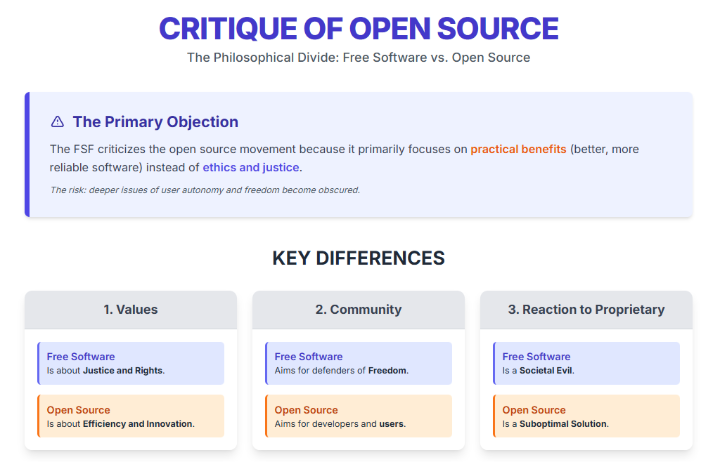
The Open Source Movement: Pragmatism and Collaboration
Development Model
The open source movement, formalized in 1998, emphasizes the benefits of open collaboration: transparency, meritocracy, and rapid innovation. The Open Source Initiative (OSI) promotes open source as a superior development model, arguing that it leads to higher quality, more flexible, and more innovative software. The OSI's definition of open source is closely aligned with the Debian Free Software Guidelines, but it avoids the ethical language of the FSF [alexn.org].
Practical Benefits
Open source proponents highlight the practical advantages of open development: reduced costs, community-driven improvement, and the ability to customize software for diverse needs. The movement has been successful in convincing businesses and governments to adopt open source solutions, often for economic rather than ethical reasons [opensource.com].
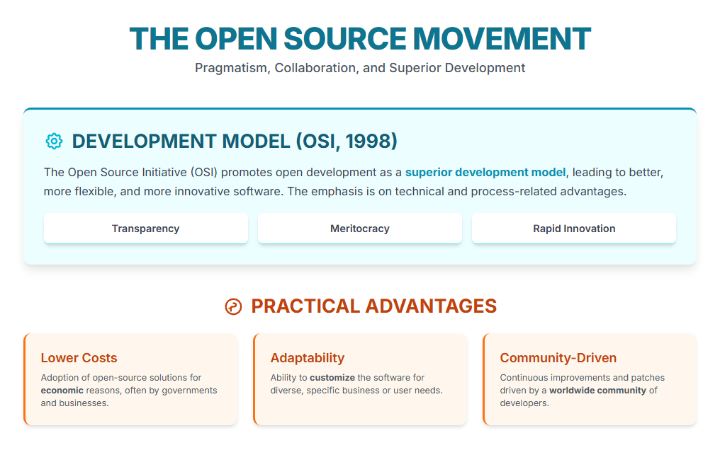
Collaboration with Free Software
Despite philosophical differences, the two movements often collaborate on projects. Many open source licenses are also free software licenses, and both communities contribute to the same codebases. However, the FSF warns that the open source movement's avoidance of ethical issues can lead to compromises that undermine user freedom, such as "tivoization", the practice of using open source code in devices that prevent user modification [mend.io]

OS-SCI: Bridging Education and Open Source
OS-SCI, an open-source educational institute, embodies the values of both movements. It uses free and open source software to deliver modular, hands-on training in Linux, Python, and other technologies. OS-SCI's approach reflects the free software movement's commitment to education and empowerment, while also embracing the open source community's collaborative, practical spirit. The organization's blog and educational programs emphasize the importance of community, sharing, and the historical roots of free software in academic and hacker culture [os-sci.com].
OS-SCI's work in India and Europe, and its partnerships with universities and open source
companies, demonstrate how free software can be both a tool for education and a means of fostering global collaboration. By teaching students to use and contribute to free and open source projects, OS-SCI helps build a new generation of technologists who understand the value of both freedom and practical innovation [os-sci.com].
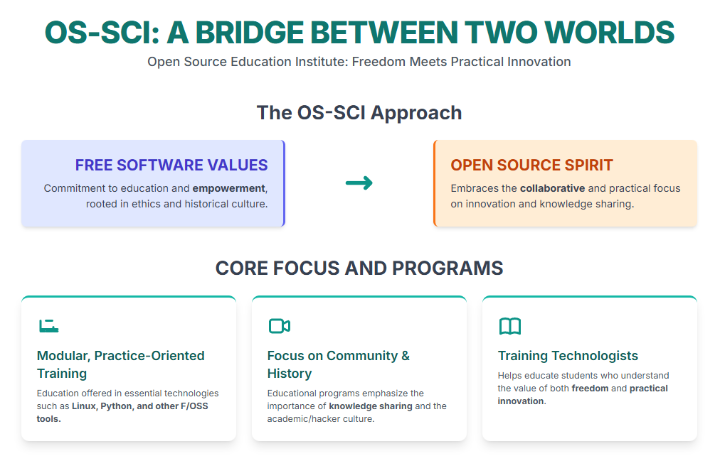
Keti Koti: A Metaphor for Free Software
The Meaning of Keti Koti
"Keti Koti" ("Breaking the Chains" in Sranan Tongo) is a Surinamese holiday celebrating the abolition of slavery on July 1, 1863. It is a day of remembrance, reflection, and celebration of freedom. The holiday is marked by cultural events, discussions about the legacy of slavery, and a commitment to ongoing struggles for justice and equality.

Why Keti Koti Resonates
• Liberation: Just as Keti Koti commemorates the end of physical chains, free software seeks to break the digital chains of proprietary software, liberating users from control by
corporations or governments.
• Community and Memory: Keti Koti is a communal act of remembrance and education,
much like the free software movement's emphasis on sharing knowledge and preserving the history of the struggle for digital freedom.
• Ongoing Struggle: Both Keti Koti and free software recognize that freedom is not a one-
time achievement but an ongoing process. The fight against proprietary software, like the
fight against systemic oppression, requires constant vigilance and action.
• Empowerment: Keti Koti celebrates the agency and resilience of formerly enslaved people; free software empowers users to take control of their technology and their digital lives.
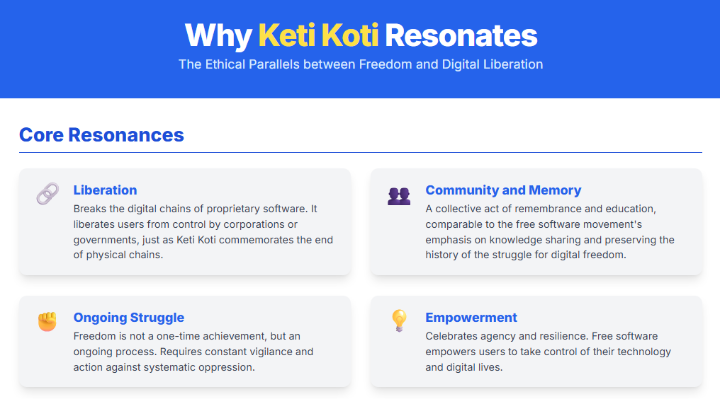
Adopting the Terminology
Using "Keti Koti" as a metaphor or even as a term for free software could help:
• Highlight the ethical stakes of software freedom, making it clear that the movement is
about more than technical or economic benefits.
• Connect with global struggles for justice, showing how the fight for digital freedom is part of a broader movement for human rights and dignity.
• Inspire a new generation of activists and developers to see their work as part of a historic struggle for liberation.
• Reflect back to the negative results of kolonialism and create a methaphor how
proprietary software companies are the new slaveholders, from which we need to brake free
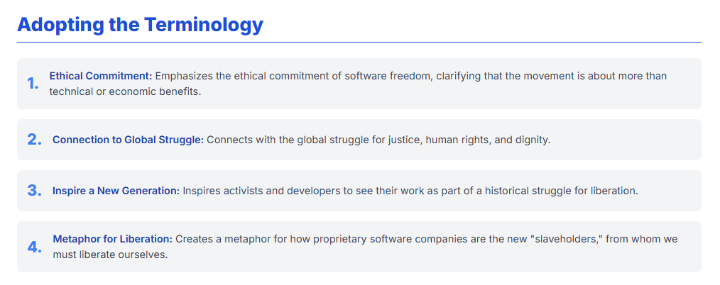
OS-SCI: Evangelists of Freedom and Collaboration
At OS-SCI, we stand at the intersection of the free software and open source movements,
embracing the strengths and values of both. Our mission is to shape tomorrow’s tech leaders with open source education, global collaboration, and an unwavering belief in "Freedom First" . We recognize that the Free Software Foundation (FSF) and the Open Source Initiative (OSI) have each played a vital role in the evolution of the digital world. The FSF’s ethical imperative, rooted in the belief that software must respect users’ freedom, has been foundational in defining what it means to be truly free in a digital age. Meanwhile, the OSI’s pragmatic approach has democratized access to technology, proving that open collaboration can drive innovation, quality, and global participation.
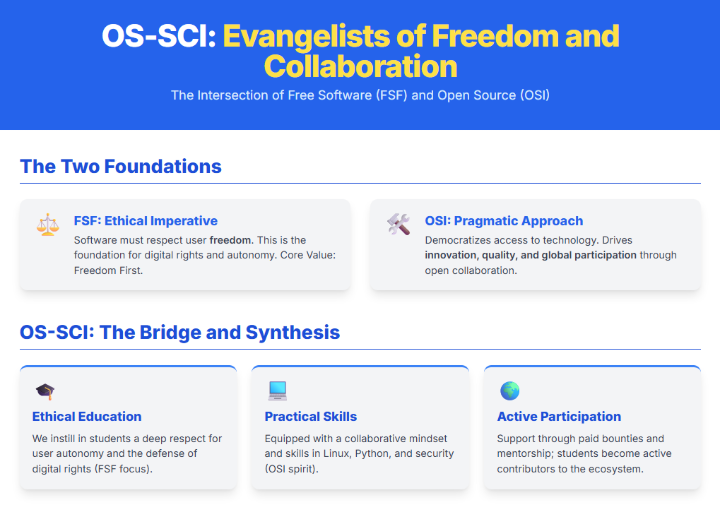
As educators and advocates, we mitigate between these two visions, not as a compromise, but as a synthesis. We teach our students the ethical principles of free software, instilling in them a deep respect for user autonomy and the importance of defending digital rights. At the same time, we equip them with the practical skills and collaborative mindset of the open source movement, preparing them to thrive in a world where technology is built by and for communities. Our modular, hands-on programs in Linux, Python, security, and more are designed to be accessible,
collaborative, and relevant, reflecting both the moral clarity of the FSF and the inclusive, innovative spirit of the OSI .
By partnering with universities, organizations, and FOSS communities across the globe, we ensure our curriculum remains cutting-edge and connected to real-world needs. We support projects like Lomiri, which embody the convergence of freedom and practicality, offering open alternatives to proprietary systems. Through paid bounties, mentorship, and real-world contributions, we empower students to become not just users, but active participants in the open source ecosystem, contributing to a future where technology is free, open, and for everyone. In this way, OS-SCI acts as a bridge, showing that the ideals of free software and the methodologies of open source are not mutually exclusive, but mutually reinforcing in the pursuit of a world where everyone can be free.

US versus THEM
The divide between Free and Open Source Software (FOSS/FLOSS) and proprietary software represents more than just a difference in licensing—it embodies a fundamental clash of values, control, and user empowerment. FOSS/FLOSS, whether rooted in the ethical imperatives of the free software movement or the pragmatic collaboration of open source, grants users the four essential freedoms: to run, study, modify, and share the software. This transparency and autonomy foster innovation, community-driven improvement, and a culture of sharing, where technology serves as a tool for collective progress rather than corporate control.
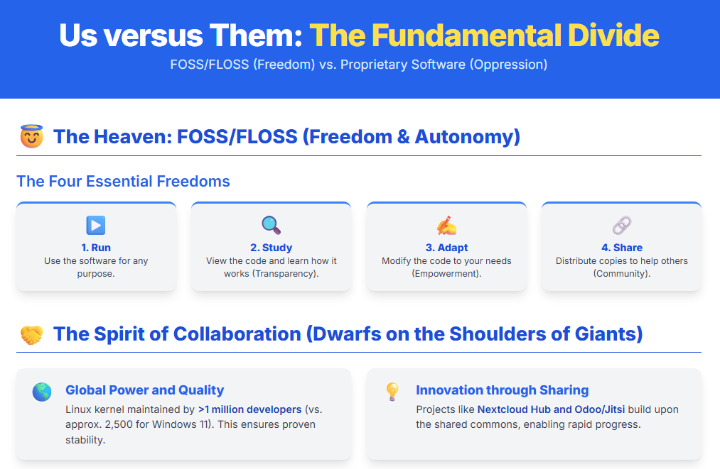
The metaphor "dwarfs on the shoulders of giants" perfectly captures the spirit of FOSS/FLOSS. Originating in the 12th century with philosopher Bernard of Chartres, the phrase means that we see further not because of our own inherent greatness, but because we build upon the knowledge and achievements of those who came before us. In the open source world, this principle is foundational: every project stands on the work of others, enabling rapid progress and innovation. For example, while Microsoft Windows 11 is developed by around 2,500 developers within a single corporation, the Linux kernel is maintained and improved by over 1 million developers worldwide, each contributing to a shared commons. Similarly, Nextcloud Hub integrates software from countless other free projects, and Odoo’s video calling feature is powered by the Jitsi project, both examples of how open collaboration allows small teams to achieve what would be impossible alone. In this "heaven" of open source, users are not just consumers but active participants, empowered to adapt software to their needs, fix bugs, and contribute to a global commons. FOSS/FLOSS thrives on trust, cooperation, and the belief that knowledge should be accessible to all, creating an ecosystem where creativity and problem-solving flourish without artificial barriers. Proprietary software, by contrast, is a digital "hell" of restriction and dependency. Users are locked into rigid, opaque systems where they have no insight into, or control over, the code that governs their devices and data. Vendors dictate terms through restrictive licenses, planned obsolescence, and
surveillance capitalism, often prioritizing profit over user welfare. This model breeds vulnerability: users are at the mercy of corporations for security updates, privacy protections, and even basic functionality. Walled gardens, vendor lock-in, and draconian digital rights management (DRM) turn technology into a tool of subjugation, where users are stripped of autonomy and forced into a cycle of compliance. While FOSS/FLOSS liberates, proprietary software enslaves, transforming users into passive subjects of a system designed to extract value rather than empower. In this paradigm, the absence of freedom isn’t just inconvenient—it’s a form of digital oppression, where the lack of control over one’s tools mirrors the loss of agency in an increasingly digitized world.
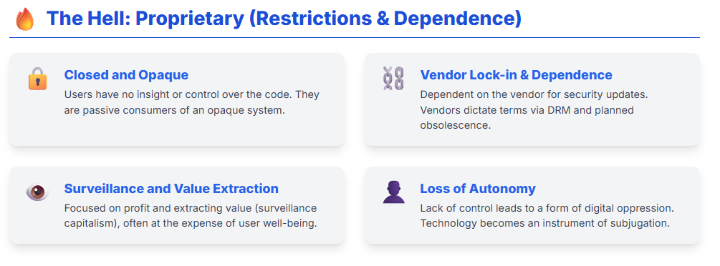
Conclusion
The debate between free software and open source is not just about words, it is about what kind of world we want to build. The free software movement's focus on ethics and freedom offers a powerful vision of technology as a tool for justice and empowerment. The open source movement's pragmatism has brought many practical benefits, but it risks losing sight of the deeper values at stake.
By adopting a term like "Keti Koti," the free software community could reaffirm its commitment to liberation and justice, while also inviting a broader public to see the connection between digital freedom and other struggles for human rights. As OS-SCI and other organizations continue to educate and advocate for free software, they can draw on the rich symbolism of Keti Koti to inspire a new wave of activists who understand that true freedom, whether digital or physical, is always worth fighting for.
Bibliography
Free Software Foundation. (n.d.). Why “Open Source” misses the point of free software. GNU
Project. Retrieved November 4, 2025, from https://www.gnu.org/philosophy/open-source-misses-the-point.html
Free Software Foundation. (n.d.). Philosophy of the GNU Project. GNU Project. Retrieved
November 4, 2025, from https://www.gnu.org/philosophy/philosophy.en.html
Free Software Foundation. (n.d.). What is free software? GNU Project. Retrieved November 4, 2025, from https://www.gnu.org/philosophy/free-sw.en.html
Free Software Foundation. (n.d.). Why “Free Software” is better than “Open Source”. GNU
Project. Retrieved November 4, 2025, from https://www.gnu.org/philosophy/free-software-for-freedom.html
LibrePlanet. (n.d.). What is the difference between Open Source and Free Software? LibrePlanet. Retrieved November 4, 2025, from https://libreplanet.org/wiki/What_is_the_difference_between_Open_Source_and_Free_Software%3
F Nedelcu, A. (2022, September 8). Open Source vs Free Software. Alexandru Nedelcu. Retrieved November 4, 2025, from https://alexn.org/blog/2022/09/07/free-software-vs-open-source/
Open Source Initiative. (n.d.). The steward of the Open Source Definition. Open Source Initiative. Retrieved November 4, 2025, from https://opensource.org/
Open Source Initiative. (2025, November 3). State of the Source at ATO 2025: Sustaining the Open Source Ecosystem. Open Source Initiative. Retrieved November 4, 2025, from
https://opensource.org/blog/state-of-the-source-at-ato-2025-sustaining-the-open-source-ecosystem
OpenSource Science B.V. (n.d.). Blog posts. OS-SCI. Retrieved November 4, 2025, from https://os-sci.com/blog
OpenSource Science B.V. (n.d.). The history of Open Source. OS-SCI. Retrieved November 4, 2025, from https://os-sci.com/blog/our-blog-posts-1/the-history-of-open-source-132
OpenSource Science B.V. (n.d.). Homepage. OS-SCI. Retrieved November 4, 2025, from https://os-sci.com
OpenSource.com. (n.d.). What is open source? OpenSource.com. Retrieved November 4, 2025, from https://opensource.com/resources/what-open-source
Stallman, R. (n.d.). When Free Software isn’t (practically) superior. GNU Project. Retrieved
November 4, 2025, from https://www.gnu.org/philosophy/when-free-software-isnt-practically-superior.html
Wikipedia. (2025, October 23). Open source. Wikipedia. Retrieved November 4, 2025, from https://en.wikipedia.org/wiki/Open_source
Wikipedia. (2025, July 26). Open-source software. Wikipedia. Retrieved November 4, 2025, from https://en.wikipedia.org/wiki/Open-source_software
e Foundation. (n.d.). What is the difference between free software and open source software? e-Foundation. Retrieved November 4, 2025, from https://e.foundation/what-is-the-difference-between-free-software-and-open-source-software/
Mend. (2025, May 7). Open Source Vs. Free Software – What Is The Difference? Mend. Retrieved November 4, 2025, from https://www.mend.io/blog/open-source-vs-free-software